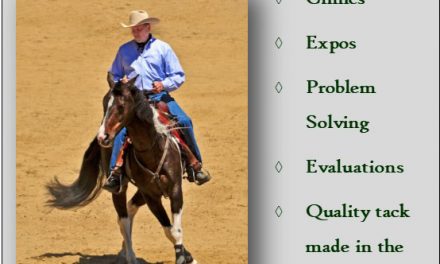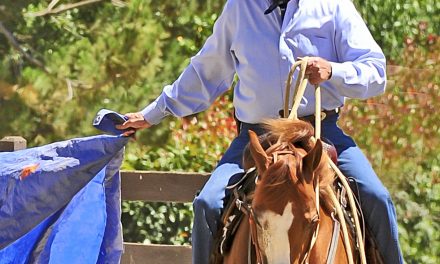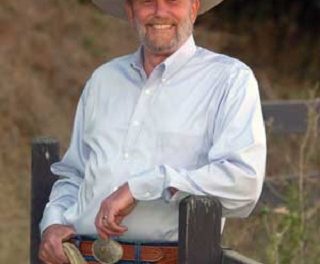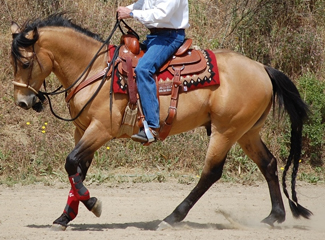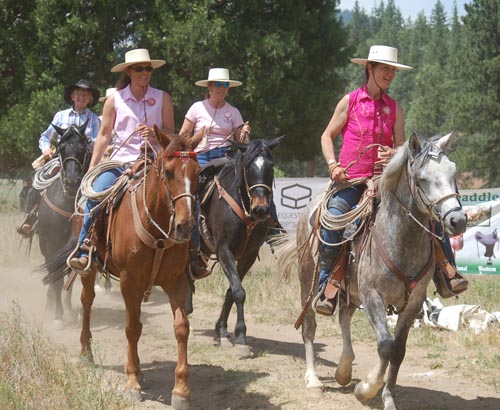
The forward cue is probably the most ignored of all the cues. It is
misunderstood and misused by most riders. I am sorry to say that it
is often not taught and so some riders really have no forward cue.
With those who do have a cue, I rarely see it practiced or
reinforced. The forward cue is probably our most important cue as
forward movement is critical for any maneuver a horse attempts. A
good, solid consistent forward cue is vital for a number of reasons.
One, without a forward cue that the horse understands and listens
to, the horse will become confused. This will cause the horse to
become cranky. The horse will show this attitude by tail swishing
or ear pinning. Most important, the driving force will not be from
behind. The horse will be pulling himself along instead of coming
up under himself and driving from the rear, or as we say, he will
not be coming through from the rear.
Out on the trail, there is always the chance that you will need to
cross an obstacle. Just because you have a forward cue doesn’t
mean your horse will be perfect on the trail or at going over objects
but it does eliminate a lot of situations that could turn nasty or
dangerous. When the horse has learned to listen to your cue it
makes your ride more pleasant.
I see many riders practice the leg yield, transitions and many other
movements but they never practice the forward cue. Each time I
ride, I reinforce the forward cue by putting the calf of my leg on
the horse and offering some pressure. Some misinterpret the
amount of pressure and think it must be a couple of pounds. The
common theory is that a horse can feel a fly on it; I know this is
true because I have watched the skin twitch when a fly lands. A
horse can also feel five to eight ounces of pressure from your calf.
In other words, you can squeeze a little bit and you don’t have to
put one pound of pressure on your horse.
If the horse does not respond, then you must follow up, which is
the key. This is a problem for a lot of riders; many don’t follow up
because when you increase the pressure, you may get an adverse
reaction. The horse may cow kick out which makes the hip rise
and can feel like a buck or the horse can just plain buck. You need
to decide if you are willing, and able to deal with a significant
reaction. Are you comfortable and confident enough to ask with a
spur or dressage stick until the horse does go forward?
Here is another key. Sometimes you think the horse is going
forward because the horse is moving forward at a trot but there is
no life in the movement. The horse is just chugging along and the
movement is sluggish. We do not want the horse to jump into a
hand gallop or a runaway trot. But, it is much easier to bring the
horse back into a relaxed gait than to get it to initially go forward
into a relaxed gait. We want life in the movement and no grudging
attitude. Because your horse is listening to your forward cue he
will have a good attitude and there will be no pinned ears or
swishing tail. Going up the trail will be a lot more fun and you will
have less concern regarding objects that must be crossed. You can
have fun going over objects because the horse will be forward and
willing all because it is listening to the forward cue.
Finally, and what is most important, the body dynamics of your
horse will change as he starts pushing himself along instead of
pulling. This is a huge factor. I get a lot of horses in training here
and they are all muscled up in the front but they have no hip
muscles and no top line. I have two horses here right now and the
owners are amazed that the horses are going forward. We have to
be willing to send our horses forward, on the ground and in the
saddle. I start with the horse on the ground to evaluate the horse in
terms of being behind the leg.
There are often consequences in making a horse go forward. If
you are not comfortable with the consequences you will need some
help to get the horse trained. Once in awhile, everyone needs a
trainer around to help keep you and your horse moving forward
with your skills. It is amazing that once you get your horse
forward and listening to your leg cues, the horse will start listening
to your seat cues. Your horse will not only move off your leg to go
forward but also laterally and to back up.
I encourage you to practice your forward cue every time you ride.
Be consistent with your cue, whether it is a squeeze or a kiss or
some combination. Make sure your horse is responsive to your leg.
You don’t want to bang on your horse and de-sensitize him to your
cue. We don’t want a dull horse, as that horse has no life in its feet
or movements and is often cranky and no fun to ride. We want our
horses to know our cues and be able to respond so that everyone
has an enjoyable ride.

